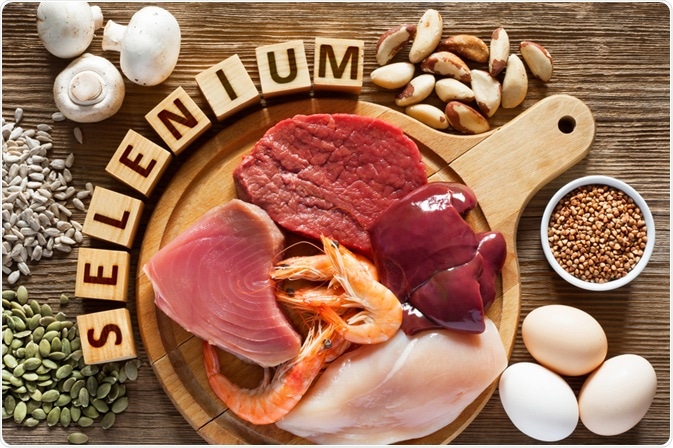Selenium is a powerful mineral that provides a wide range of health benefits, particularly for the proper functioning of the immune system. Selenium can be found in various types of foods, as well as in several forms throughout the environment.

Image Credit: Evan Lorne / Shutterstock.com
Dietary sources
Dietary sources of selenium may contain organic or inorganic selenium.
Organic forms of selenium include selenomethionine and selenocysteine, whereas the inorganic forms include selenates and selenites. In plants, organic selenium arises from the inorganic selenium compounds in the soil. Plants that accumulate selenium include alfalfa, cruciferous species such as cabbage, broccoli, and cauliflower, as well as yeasts.
Most selenium in animal tissue is in the form of selenomethionine, which is primarily stored in the skeletal muscle. In fact, it is estimated that the skeletal muscle stores anywhere from 28% to as much as 46% of the body’s selenium. Seafood and organ meats are noted as the food products that contain the highest concentrations of selenium, while other good sources include muscle meats, cereals, and dairy products.
Plant foods show a wider variation in selenium content as compared to animal foods. This is largely due to the diversity of factors that affect selenium uptake by plants, such as the ph of the soil, the selenium compound in the soil, as well as the action of homeostatic mechanisms that keep selenium content in various tissues within limits.
Environmental sources
Elemental selenium is found in the form of metallic crystals which are gray to black. This form of selenium is mostly insoluble and therefore does not readily enter the food chain. However, natural selenium is often combined with sulfides, copper, silver, nickel, and lead. In addition, selenium forms white or colorless crystals in combination with oxygen.
Selenium in the water may result from the weathering of rocks, Selenium absorption by plants is highest when the soil is alkaline and when the selenium is in the form of inorganic compounds which dissolve readily in water and do not adsorb to soil particles.
Selenium may also enter the water cycle through irrigation runoff, thereby allowing for its entrance into the food chain from aquatic organisms.
Elemental selenium is found deep in the soil; however, it can be oxidized at the soil surface to form selenium dioxide.
Rock weathering also leads to the release of selenium dust into the air. The latter may also accompany volcanic eruptions or fossil fuel combustion. Gaseous selenium compounds include hydrogen selenide gas.
References
Further Reading
Last Updated: Nov 8, 2022